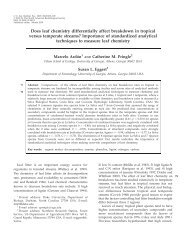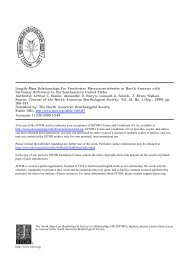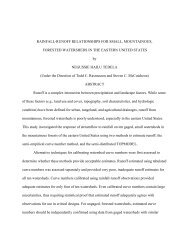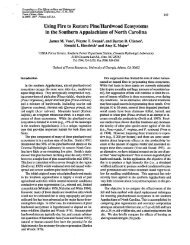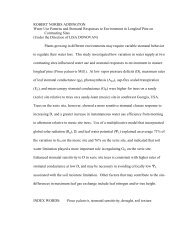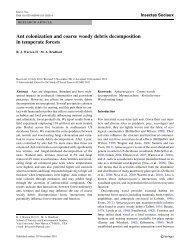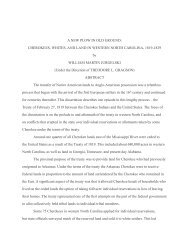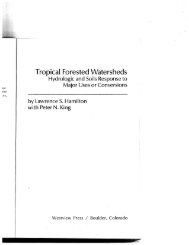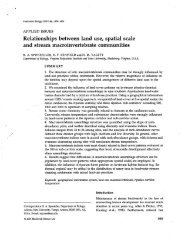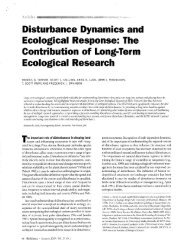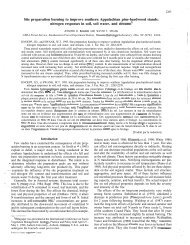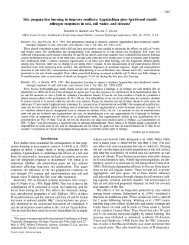biology join - Coweeta LTER - University of Georgia
biology join - Coweeta LTER - University of Georgia
biology join - Coweeta LTER - University of Georgia
You also want an ePaper? Increase the reach of your titles
YUMPU automatically turns print PDFs into web optimized ePapers that Google loves.
Articles<br />
Figure 3. Examples <strong>of</strong> long-term experiments related to global change in the Long-Term Ecological Research (<strong>LTER</strong>)<br />
Network. (a) Application <strong>of</strong> calcium silicate to an experimental watershed at the HRB site to mechanistically examine<br />
acid-rain impacts (photograph: US Forest Service); (b) the multifactor BioCON experiment at the CDR site with<br />
manipulations <strong>of</strong> carbon dioxide, nitrogen, and biodiversity (photograph: David Tilman); (c) Lake acidification curtain<br />
in a lake at the NTL site to assess whole-system impacts <strong>of</strong> changes in pH (photograph: Carl J. Watras); (d) soil-warming<br />
experiment at the HFR site (plot delineated by the lack <strong>of</strong> snow in winter; photograph: Jerry M. Melillo); (e) automated<br />
trace-gas chambers for assessing the impacts <strong>of</strong> different management practices in field crops at the KBS site (photograph:<br />
Julie E. Doll, Kellogg Biological Station <strong>LTER</strong> Program); (f) litter-exclusion experiment at the CWT site designed to allow<br />
the examination <strong>of</strong> the importance <strong>of</strong> terrestrial energy inputs into streams, which also has relevance for evaluating the<br />
impacts <strong>of</strong> mountaintop mining practices (photograph: Sue L. Eggert). Site abbreviations are defined in table 1.<br />
The value <strong>of</strong> long-term ecological experiments<br />
On the basis <strong>of</strong> the working-group meeting and the broader<br />
site survey, we highlight below the diverse array <strong>of</strong> insights<br />
and contributions provided by long-term ecological experiments<br />
within the <strong>LTER</strong> Network. Our goal is to extend our<br />
review beyond the core scientific benefits <strong>of</strong> this suite <strong>of</strong><br />
studies to include unique opportunities and broader impacts<br />
afforded by these long-term experiments.<br />
Insights into long-term responses. Obviously, but not trivially,<br />
one <strong>of</strong> the greatest scientific benefits <strong>of</strong> long-term site-based<br />
experiments is that they elucidate how ecological systems<br />
respond to experimental treatments over the long term.<br />
Indeed, such experiments have repeatedly demonstrated<br />
that long-term responses to treatments can differ markedly<br />
from short-term responses (Tilman 1989, Debinski and Holt<br />
2000). For example, in the BioCON experiment at the CDR<br />
site (biodiversity, CO 2 , and N are manipulated; see figure 3),<br />
Reich and colleagues (2006) tested the hypothesis that the<br />
availability <strong>of</strong> N would constrain the response <strong>of</strong> productivity<br />
in an N-poor grassland community to elevated CO 2 .<br />
Although this hypothesized interaction between N and CO 2<br />
eventually became apparent, it was not until the fourth year<br />
<strong>of</strong> treatment. If the experiment had been discontinued before<br />
the fourth year (i.e., within the time frame <strong>of</strong> typical funding<br />
cycles), researchers might have concluded that N availability<br />
had no effect on the response <strong>of</strong> these communities to elevated<br />
CO 2 . Similarly, in a manipulation <strong>of</strong> soil temperature<br />
at the HFR site (figure 3), the conclusion regarding the influence<br />
<strong>of</strong> warming on soil respiration would have been very<br />
different had the experiment ended after its first few years<br />
(figure 4). In that experiment, warming strongly increased<br />
382 BioScience • April 2012 / Vol. 62 No. 4 www.biosciencemag.org



